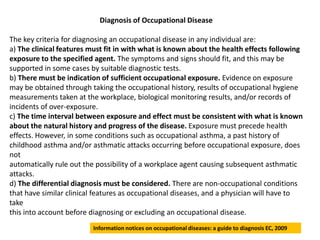
A guide to diagnosis ec
- 1. Diagnosis of Occupational Disease The key criteria for diagnosing an occupational disease in any individual are: a) The clinical features must fit in with what is known about the health effects following exposure to the specified agent. The symptoms and signs should fit, and this may be supported in some cases by suitable diagnostic tests. b) There must be indication of sufficient occupational exposure. Evidence on exposure may be obtained through taking the occupational history, results of occupational hygiene measurements taken at the workplace, biological monitoring results, and/or records of incidents of over-exposure. c) The time interval between exposure and effect must be consistent with what is known about the natural history and progress of the disease. Exposure must precede health effects. However, in some conditions such as occupational asthma, a past history of childhood asthma and/or asthmatic attacks occurring before occupational exposure, does not automatically rule out the possibility of a workplace agent causing subsequent asthmatic attacks. d) The differential diagnosis must be considered. There are non-occupational conditions that have similar clinical features as occupational diseases, and a physician will have to take this into account before diagnosing or excluding an occupational disease. Information notices on occupational diseases: a guide to diagnosis EC, 2009
- 2. As an additional aid to diagnosing occupational diseases, retain the following concepts for exposure: i. Minimum intensity of exposure – This is the minimum level of exposure that is required to cause disease. Lower exposures are unlikely to lead to occupational disease. This concept is applicable especially for toxic agents. For agents that are carcinogenic or allergenic, it is not usually possible to define a minimum threshold dose. Direct acting carcinogens in molecular amounts are in theory capable of affecting cellular DNA and initiating carcinogenesis. However, for some carcinogens, it may be possible to identify a threshold of initiation of adverse health effects. Allergens may require substantial exposure to cause sensitization. But once an individual is sensitized, minute amounts can be capable of eliciting an allergic response. ii. Minimum duration of exposure This is the shortest exposure period for which disease can occur. Periods of exposure less than this are unlikely to cause disease. iii. Maximum latent period This refers to the length of time from cessation of exposure, beyond which it is unlikely that any disease can be attributed to the exposure. E.G., , acute myocardial ischemia occurring a year after an acute exposure to carbon monoxide is not attributable to that exposure. iv. Minimum induction period This is the shortest period from beginning of exposure to beginning of disease below which the exposure would have been unlikely to have caused the disease. For example, lung cancer developing within a year after first exposure to asbestos is unlikely to be attributed to that exposure Information notices on occupational diseases: a guide to diagnosis EC, 2009